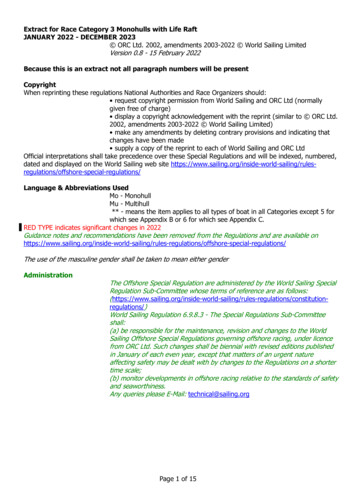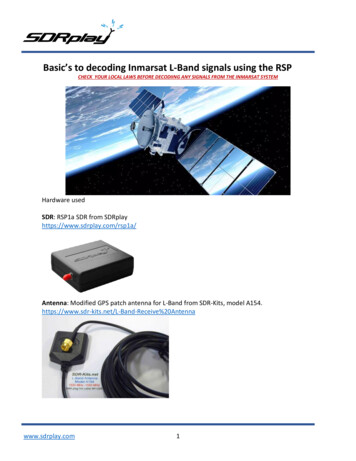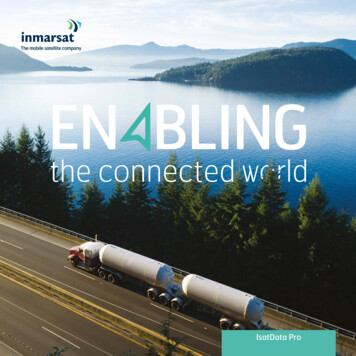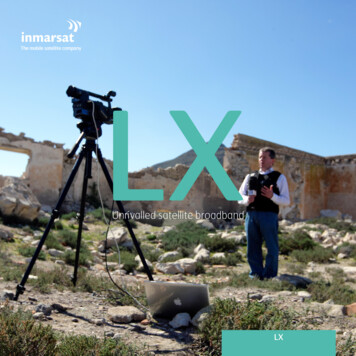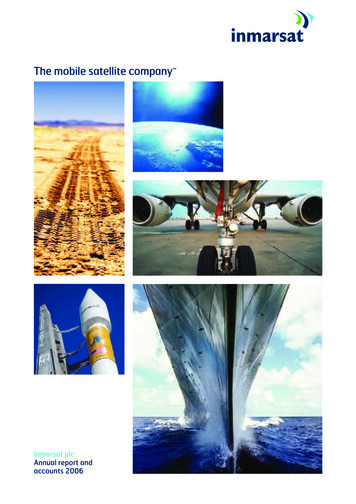
Transcription
The mobile satellite company Inmarsat plcAnnual report andaccounts 2006
Company overviewInmarsat is the world’s leading provider of acomprehensive portfolio of global mobile satellitecommunications services for use on land, at seaand in the air.We provide voice and data connectivity toend-users through the most versatile and reliablesatellite network in the world, giving us thecapability to deliver innovative services andsolutions on an unprecedented scale.Contentsifc Company overview01 2006 highlights02 Chairman and Chief ExecutiveOfficer’s Business Review12 Financial Review19 Board of Directors20 Board Committees and Advisers20 Executive Management Board21 Directors’ Report24 Statement on Corporate Governance29 Corporate Social Responsibility30 Directors’ Remuneration Report40 Independent Auditors’ Report to theMembers of Inmarsat plc42 Consolidated Income Statement42 Consolidated Statement of RecognisedIncome and Expense43 Consolidated Balance Sheet44 Consolidated Cash Flow Statement45 Notes to the Consolidated FinancialStatements77 Independent Auditors’ Report to themembers of Inmarsat plc78 Inmarsat plc – Company FinancialStatements78 Company Balance Sheet78 Reconciliation of Movements inShareholders’ Funds79 Notes to the Financial Statements80 Five Year Summary80 Global Contact Details80 Financial Calendar 2007ibc Product overviewCautionary statement regardingforward-looking statementsCertain statements in this annual report constitute‘forward-looking statements’ within the meaning of theUS Private Securities Litigation Reform Act of 1995. Theseforward-looking statements involve risks, uncertaintiesand other factors that may cause our actual results,performance or achievements, or industry results, tobe materially different from those projected in theforward-looking statements. These factors include:general economic and business conditions; changes intechnology; timing or delay in signing, commencement,implementation and performance of programmes,or the delivery of products or services under them;structural change in the satellite industry; relationshipswith customers; competition; and ability to attractpersonnel. You are cautioned not to rely on theseforward-looking statements, which speak only as ofthe date of this annual report.Inmarsat undertakes no obligation to update or reviseany forward-looking statement to reflect any changein our expectations or any change in events, conditionsor circumstances, except where we would be requiredto do so under applicable law.Atlas V image courtesy of International Launch Servicesand Lockheed Martin Corporation.Inmarsat network and technologyHow it workswwwStage oneUse any phone orinternet connectionin the world.Stage twoConnect using anInmarsat satelliteterminal. The terminalsends and receivescommunications signalsfrom an Inmarsatsatellite connectingwith your laptop,phone or camera.Stage threeThe satellite signal isreceived back into theterrestrial network andthe communication linkis completed tovirtually any phone orinternet connection inthe world.
Company overviewInmarsat has stood at the forefront of themobile satellite services (‘MSS’) industry fornearly 30 years. We have unique, unrivalledexperience in designing and operatingsatellite communications networks. We areinternationally recognised as pioneers inour field and continue to introduce newtechnologies that redefine the standardsfor our industry.The Inmarsat name is synonymous with reliable, secure,global mobile satellite communications. We offer acomplete portfolio of mobile voice and data servicesto almost anywhere on the planet, whether on land,at sea or in the air.Our customers include major corporations fromthe maritime, media, oil and gas, construction andaeronautical industries, as well as governmentsand aid agencies.PartnersInmarsat’s leading-edge solutions and services areavailable through our world-class network of distributionpartners, service providers and manufacturers, providingterminals and services to end-users throughout the world.With extensive industry expertise, many Inmarsat partnersspecialise in particular markets – developing products andsolutions that meet the specific needs of their customers.MSS revenue by sector 200612%6%MaritimeLand Land mobileInmarsat offers an unparalleled range of voice, fax and dataservices to suit all types and tonnages of vessel from small yachtsto the largest ocean-going ships, enabling seafarers to communicateas effectively on board as they can when they are on shore.Our users include businesses operating in remote areas orthose who are travelling to these environments and needaccess to the same communications offered by their office.Thousands of vessels in the merchant, fishing, leisure andgovernment sectors rely on our services for position reporting,weather and navigational chart updates and for enabling crew tocall or email friends and family – a vital resource for maintainingmorale when away at sea for potentially months on end.The first new service to be launched on the Inmarsat-4satellites was our Broadband Global Area Network service(‘BGAN’). BGAN is the fastest growing service in our history andhas already been used commercially in over 175 countries bycustomers in a wide range of sectors including media,government, oil and gas and aid.Inmarsat’s role in providing safetyservices remains important to us.Our satellite services form the coreof the Global Maritime Distress andSafety System (‘GMDSS’). Manylives have been saved thanks toInmarsat and seafarers can besecure in the knowledge that helpis at hand at the touch of a button.Our new handheld voice servicecompletes our portfolio of mobilesatellite services.AeronauticalGovernmentInmarsat was the first civil operator to introduce satellitecommunications services for the aeronautical industry, withthe launch of its Aero H service in the early 1990s. Today, withmore than 8,000 aircraft in the air transport, business aviationand government sectors relying on global in-flight voice anddata connectivity from Inmarsat, we are the most widely usedsatellite operator in the industry.Inmarsat offers a variety of tailored and off-the-shelfsolutions designed to meet the growing demand forworldwide communications in support of modern militaryand homeland security operations. Whether the mission lieson land, at sea or in the air, Inmarsat enables organisationsto create the secure mobile networks required for effectivenetwork-centric operations.Inmarsat is currently the only satellite operator to provideglobal aeronautical safety services that comply with thesafety requirements of theInternational Civil AviationOrganisation. This allows aircraftoperators to fly safely and moreefficiently outside traditionalradio coverage.Civil governments, the UN and aid agencies also counton Inmarsat’s flexible, highly portable solutions to maintainessential communicationsfor their mobile and remoteteams who deliver a range ofdisaster-relief, peacekeepingand telemedicine activities.
In-orbit operationsInmarsat’s constellation of ten satellites, positioned in geostationary orbit 36,000 kmabove the earth’s surface, are controlled from Inmarsat’s head office in London, UK.In 2005, we launched two new satellites (Inmarsat-4) which, between them, coverapproximately 85% of the world’s landmass covering around 98% of the world’spopulation.Our satellites are deployed around the world in nine orbital locations spaced apart inorder to minimise harmful interference and maximise spectrum re-use. These orbitallocations provide global coverage with some overlaps in areas of higher trafficdensity and have been named after the primary ocean regions covered.Our first satellite was launched in October 1990 with the most recent launchin November 2005. We have a third Inmarsat-4 satellite waiting to be launched.During 2006, we decommissioned our first satellite after 15 years’ service.SpectrumInmarsat operates all its services in the L-band spectrum. This is a vital resourceallowing mobile or portable end-user terminals to communicate with our satellites.Three global satellite constellationsInmarsat-4 constellationInmarsat-4 constellationNumber of satellites: orbitalpositionF1Beyond2020F2Beyond2020Mar 2005Nov 2005IORAOR-WF3F3 satelliteis built,tested andready forlaunch.Final launchdate to beconfirmed.Inmarsat-4 orbital positions will change following the launch of F3Inmarsat-2 and Inmarsat-3 constellationsInmarsat-2 constellationNumber of satellites: 3SatelliteCurrentoperationallifeLaunch 016Oct 1990PAC-WMar 1991PAC-EDec 1991Apr 1992IND-EF12012F22013F32012F42010F52014Apr 1996IORSep 1996AOR-EDec 1996PORJun 1997PAC-CFeb 1998IND-WInmarsat-3 constellationNumber of satellites: 5SatelliteCurrentoperationallifeLaunch datesOrbitalposition
2006 highlights– Continued strong maritime and aeronauticalsector contributions– Fast growing BGAN contribution– Data represents over 70% of‘on-demand’ revenues– Entry into handheld voice marketTotal revenueUS 500.1m2005: US 491.1mOperating ProfitUS 174.9m2005: US 209.5mEBITDA (US m)Revenue by Data and Voice (US 06VoiceEBITDAUS 331.7mMSS revenues (US m)2005: US 316.0m500Active terminals (’000)2504732Final dividend per share4004104364594732004.930015016 cents (US )2001002005: 10.95 cents (US )1005028 cents (US )2005: 17 cents (US )01Inmarsat plcAnnual report and accounts .16.880.876.9122.6139.500Basic earnings per share7.74922003Global Land mobile20052006Maritime
Chairman and Chief Executive Officer’sBusiness ReviewWe reported total revenues of US 500.1m in 2006 compared toUS 491.1m in 2005, with EBITDA (earnings before interest, tax,depreciation and amortisation) improving from US 316.0m toUS 331.7m.During 2006, revenues from mobile satellite communicationsservices were US 491.8m, an increase of US 19.3m, or 4.1%,compared with 2005. Growth has been strong as a result ofcontinued success in services such as Fleet and Swift 64 for ourmaritime and aeronautical customers respectively and as a resultof the launch of BGAN in December 2005. Since September2006, we have also seen a revenue contribution from handheldservices. If we excluded two one-time revenue benefits in 2005,plus the higher level of volume discounts we had in 2006, weestimate that the Company’s underlying revenue growth wasaround 5.5%, which is in the initial range of 5 to 6% growth thatwe set out at the time of the IPO.Andrew SukawatyChairman and Chief Executive OfficerI am pleased to report that these results have enabled us toincrease our dividend payments, with the Inmarsat plc Boardrecommending a final dividend of 16 cents (US ) per sharemaking a full year dividend of 26.66 cents (US ), an increase of4.1% over 2005. Continuing our strong operating performancein future will help us deliver our commitment to target dividendgrowth in line with growth of our normalised free cash flow.Our Board is now in its second year together. The depth ofexperience and varied background of our Directors hascontributed to an informed evolution of our strategy anddirection as a Company.In 2006, we delivered on the target we had set out inJune 2005 when we listed on the London Stock Exchange(‘the IPO’) to increase revenues while maintaining stronggrowth in operating cash flows. Our revenue growth hascontinued to be driven by solid performances across ourbusiness sectors and by the fast growing contributionfrom our new broadband service, Broadband Global AreaNetwork (‘BGAN’).At the half year, I advised shareholders that Kathleen Flahertyhad joined the Board and I believe that Kathleen’s extensiveexperience and perspective will prove to be valuable to thedevelopment of our business. Biographies of all our Directorsare given on page 19.StrategyThe strategy that we outlined at the time of the IPO in June 2005reflected multiple opportunities for the Company to grow itsbusiness and I am pleased to confirm that we have seen severalInmarsat’s StrategyPerspectivesCustomer/MarketHighly reliable/trustedfor data transmissionon the moveBundled value voiceCompetitive reliablehandheld servicePremium services– good value02Inmarsat plcAnnual report and accounts 2006Industry PositionTo be the leading mobile satellite services (‘MSS’) providerTechnology leader in MSSBroad range of leading innovative servicesPremium services – good valueApplications/Market DrivenTo serve mission critical needs with mobile applications whereterrestrial networks are not effective or are non-existentFinancialTo deliver superior total shareholder returns by increasingrevenue growth on a largely fixed cost baseOperationalHighest reliability standardAccelerate revenuegrowth in core businessand new servicesMaintain fixed costbase through primarilywholesale approachand capex holidayA professionally rewarding,challenging and enjoyableplace to work
key initiatives started during 2006 which will have an increasingimpact during 2007. The focus of our strategy is to enablecustomers to use us on a daily basis in business critical andoften life-saving tasks globally. Our services are relied upon insituations where other networks either do not exist or cannotserve the customer due to limitations of their service coverageor due to the fact that our system can be accessed and worksthe same way globally.Underpinning our strategy is the healthy core business uponwhich we have built our reputation. For nearly 30 years,we have delivered a high quality, robust, reliable service forour partners and customers. The core business is now enhancedby our broadband offering, BGAN, using our recently launchedInmarsat-4 satellites. BGAN combines data access at broadbandspeeds with a simultaneous voice capability, which canbe used across all our land-based market sectors. While weexpect migration over time from our existing products to thisnew combined data/voice service, we already see positivesigns of how BGAN is being used in new sectors and withnew applications.During 2005, we successfully launched two Inmarsat-4 satelliteswhich together cover approximately 85% of the earth’s landmassand 98% of the world’s population. We built three satellites aspart of the Inmarsat-4 programme and in January, we confirmedthat we have exercised our option to launch the third, which isalready built, has been fully tested and is currently in storage.We hope to launch this satellite in late 2007 or 2008. As aconsequence of this launch, we are constructing a third SatelliteAccess Station in Hawaii. We believe that many of our keycustomers such as governments, airlines and many of the world’slarge shipping fleets, already understand the benefit of theincreased coverage for our broadband and new handheldservices that the launch of the third satellite will bring.At the beginning of 2006, we highlighted our intention to enterthe mobile satellite handheld market. Adding a handheldsatellite phone capability to our portfolio provides us with theability immediately to enter this market. In September 2006,Inmarsat and ACeS International Limited (‘ACeS’) announced the12completion of collaboration arrangements to offer low-costhandheld and fixed voice services, initially in the Asian marketwith extended coverage subsequently using the Inmarsat-4satellites. Adding a handheld product to our portfolio completesour broad customer offering, and also positions us to offer usersa guarantee of service continuity beyond the end of the nextdecade using the Inmarsat-4 satellites.We have on-going activities to seek out opportunities fordeveloping a hybrid satellite terrestrial system in the US andCanada. We have continued our involvement in the Galileoprogramme which is developing the European GlobalPositioning System.We are increasingly focused on spectrum and how we manageour existing spectrum in the L-band effectively and efficiently,through our negotiations at the international spectrumco-ordination meetings as well as reviewing how we can mostefficiently provide our own services. This allows us to grow ourbusiness while staying within the agreed allocations of spectrum.The Inmarsat-4 satellites also allow us to offer services in a muchmore efficient manner and use our spectrum more effectively. Ourpolicy is to review opportunities where we could also expand ourofferings in other frequency bands and we will continue to do thiswhere there is benefit for the Company and our customers.Review of operations2006 saw the start of the investment return from the US 1.5bnInmarsat-4 programme underpinned by the solid performanceof our MSS business. We have once again enjoyed increasingdata traffic, validating our investment in our new satelliteconstellation and development of broadband services. Over 70%of our revenues comes from data usage from our ‘on-demand’service and we believe there is a growing market for us to deliverthese services to new and existing users. The number of activeterminals has continued to increase, bolstered by thoseregistered for the new BGAN service and the number of activehandheld terminals. Once again, we are proud to report on theoutstanding reliability of our network, with average availabilityacross our heritage services of 99.99%. In 2006, we alsosuccessfully deorbited our first satellite after 15 years of service.31 The new low-cost handheldservice extends Inmarsat’s broadcustomer offering.2 Broadcasters have integratedBGAN into their standard mix ofcommunications technology, andthe service is now an establishedmethod for delivering both liveand recorded video reports.3 BGAN is the world’s first mobilecommunications service to offersimultaneous voice and broadbanddata connectivity.03Inmarsat plcAnnual report and accounts 2006
Maritime04Inmarsat plcAnnual report and accounts 2006
05Inmarsat plcAnnual report and accounts 2006
MaritimeMaking waves: the route to BroadbandDuring 2006, revenues from the maritime sector were US 284.7m, an increase ofUS 17.6m, or 6.6%, compared with 2005.Data revenue growth in this sector has grown strongly through the year driven byincreased use of our Fleet product range which offers higher data speeds, voiceservices and safety and distress call capabilities. We announced at the half year thatthe 10,000th Fleet terminal was activated on the MV Morning Midas, a car carrierthat installed the high-speed service to support a range of corporate and crewcommunications. This growth has been assisted by the use of our terminals in thenew build market. We have seen sustained revenue growth per terminal over the year,which reflects the strong take up of the Fleet service that we are now seeing withinthe maritime sector.As well as growth in our three Fleet services, there has also been increased usage ofour other principal maritime services – Inmarsat B and Mini M. Maritime voice revenuehas benefited from stabilisation over the year and although we have seen increasedvoice traffic, the average price of maritime voice services was lower, due to the impactof volume discounts given to our distributors and the continuing shift in traffic mix tolower priced crew calling services from our more expensive analogue service. Ouranalogue service, Inmarsat A, ceases service at the end of 2007 so the impact ofanalogue migration will reduce as we move through 2007.We are also excited by the prospect of our new handheld service which is already usedby ships’ crews through the collaboration arrangements we have with ACeS. With theexpansion of the service footprint, we see opportunities to grow this business as weenter for the first time what is now an established global market.During 2005 and 2006, Inmarsat was the official provider of satellite communicationsto the round-the-world Volvo Ocean Race, which saw each of the competing yachtsequipped with the latest Inmarsat Fleet communications technology and Inmarsat Cequipment. The technology allowed crews and families, sponsors and technical teamsto remain in constant contact throughout the race, capturing the excitement of thevoyage as it happened. Being used in these extreme conditions clearly demonstratesthe robust and reliable nature of Inmarsat services.Our FleetBroadband offering, which is planned for service launch late in 2007, willanswer the needs of a growing maritime user base for higher data speeds. This willenable them to operate at an even more efficient level at sea and thus manage theirbusinesses more cost effectively. It will also allow for cost effective communication bycrew to family and friends while at sea, using email, text and voice calls. The welfareof the crew is a growing requirement of our large maritime customers.Maritime OverviewMSS revenue 2006Maritime SectorMaritime revenue 200635%42%58%65%MaritimeOther04Inmarsat plcAnnual report and accounts 200658%42%VoiceData35%65%
Medical response from Esperanza del MarAs videoconferencing technologyprogresses in terms of affordability,ease of use and faster data rates, sothe concept of telemedicine has similarlygathered pace. Once, those responsiblefor ill or injured parties in isolatedlocations would have had to make theirown diagnoses, perhaps obtaining asecond opinion by telephone, if onewas available. Now it is possible totransfer clear images, video, vital signsand other essential information directlyto hospitals in real time.The maritime industry is one thatcan clearly benefit from this type oftechnology and, thanks to Inmarsatenabling a vital ship-to-shorecommunication link, it is being embracedaround the globe helping to save lives atsea. One prime example is the Esperanzadel Mar (Hope of the Sea), an 85mhospital ship owned and operated bythe Spanish ministry of works’ InstitutoSocial de la Marina (ISM), the departmentresponsible for providing medicalservices to seafarers, particularlythose in the fishing fleet.Handling an average of 30 patients amonth, the Las Palmas-based ship isready to answer distress calls from vesselsnavigating between west Africa and theCanary Islands. Onboard medical staffinclude a general doctor, a surgeon,an anaesthetist and a nurse.is linked directly to two of the 128kbpsFleet 77 terminals, which togetherdeliver data rates of up to 256kbps.Jesus Vilares, president of Comitas’agent Vilsat Communications, says:‘This system provides double the speedof a standard 128kbps Fleet 77, which isespecially useful in an emergency whendemand for telemedicine bandwidthincreases. Working with 128kbps,we’d typically allocate about 90kbps tovideo-conferencing, and the remaining38kbps to other medical services. Butwith 256kbps, we use some 200kbps forvideoconferencing, and this is producingnear perfect visuals and sound.’Vilares comments: ‘The cost of runninga 256kbps Fleet 77 set-up is minimalcompared to arranging an emergencyevacuation. We’ve managed to reducethe time taken to send some of theX-ray scans from the ship to the hospital.Depending on size, in some caseswe’ve done this in just 30 seconds.’There is an onus on ships’ masters,whether in charge of fishing vesselsor cruise liners, to stabilise the conditionsof afflicted crew or passengers.Telemedicine goes some way to makingthis happen and coupled with Inmarsat’sFleet 77 service, this technology ensuresthe efficient operation of a vessel bylimiting evacuations in emergencies butmore importantly, helping to save lives.The Esperanza del Mar also boastsno fewer than three Inmarsat Fleet 77terminals, as well as an advanced ComitasTM-64 telemedicine system. The TM-6411 The Esperanza del Mar answersdistress calls from vesselsnavigating between the west coastof Africa and the Canary Islands.
Land Mobile06Inmarsat plcAnnual report and accounts 2006
07Inmarsat plcAnnual report and accounts 2006
Land MobileBroadband for a mobile planetIn 2006, revenues from the land mobile sector were US 116.1m, a decrease of US 5.7m,or 4.7%, compared with 2005. Although revenues from data services were slightly lowercompared to last year, due to a reduction in traffic in the Middle East and competitionfrom fixed satellite operators, we have been very encouraged by the consistentperformance of our R-BGAN service and growing contribution from our new BGANservice. In the last quarter of 2006, with the contribution from these two services, ourland data revenues showed an increase that more than offset the increases in volumediscounts we would normally see in the fourth quarter of the year. 2006 was the firsttime we reported BGAN performance figures and it was promising for us to reporthow the service is growing. One characteristic of the BGAN service is that we receivesubscription revenues per terminal, which provides a regular revenue flow. Already weare seeing different usage patterns developed. It depends upon situational use butwe often see multiple users accessing their office LANS and making calls through oneterminal whereas others may use the service as a back-up, ensuring that communicationchannels will be available if needed. BGAN has been deployed in more than175 countries to date, with uses ranging from live CNN and BBC news reports inAsia Pacific to storm chasers in the southern US.Since its launch, our BGAN service has been Inmarsat’s fastest growing service overits first year of introduction and with 2007 as the first full year contribution from thetwo Inmarsat-4 satellites, we are very excited by the prospects for the year ahead. Wehave seen BGAN used more widely in our core markets and deeper penetration innew markets. Our services are delivered to end customers by a world-class network ofinnovative distribution partners. Eight new BGAN distribution partners were appointedduring 2006, bringing the total to 16, and we believe that these new partners will helpto drive demand from new customers in new market segments.Our market share of voice revenues in the land mobile sector continued to reduceduring 2006 due to increasing competition from other handheld satellite operatorsand, in some areas, from terrestrial operators expanding their coverage area. Therewas a small revenue contribution in the last quarter from the handheld service we nowoperate through the ACeS collaboration. As a result of these arrangements, we not onlybegan servicing on a wholesale basis an active base of handheld terminals, but we nowalso have a talented and capable workforce in Batam, Indonesia. We expect revenuesfrom our handheld business to grow strongly over the coming years, over an enlargedfootprint in 2007, and even more widely at the end of 2008 when it will be extendedfurther over the Inmarsat-4 satellites.We believe that our entry to the handheld market extends and enhances our portfoliooffering and positions us to offer users continuity of service on the Inmarsat-4 satelliteswell beyond the next decade on a global basis. This offers clear service benefits tocustomers compared to other handheld operators.Land Mobile OverviewMSS revenue 2006Land SectorLand revenue 200617%24%76%LandOther06Inmarsat plcAnnual report and accounts 200683%24%76%VoiceData17%83%
CNN in actionAs every journalist knows, news becomesless newsworthy as time passes, so filingcopy fast and getting your version intoprint before the competition does iscrucial. This rule applies equally totelevision news, where broadcasterscompete to be first on air with livefootage from the latest war zone ordisaster. But here the process is not assimple as for print reporters, who canalways file copy as long as they haveaccess to a telephone. The televisionnews reporter requires heavy-dutytechnology, such as a microwave orsatellite connection, to broadcast outsidethe studio and into our living rooms.The arrival of our BGAN service has thepotential to kick start a revolution intelevision coverage of breaking news.The service presents a compellingproposition to the professionalbroadcaster, because the terminals aresmall and as easily portable as a laptopcomputer. BGAN also has two core videooptions for broadcasters: live video, viastreaming IP or ISDN, and store-andforward video via streaming IP, ISDNor standard IP, giving great flexibilityto the broadcaster, depending on howaggressive their deadlines may be.CNN, one of the world’s leadingbroadcasters, has been an early andenthusiastic adopter of live video overIP and of the BGAN service. ‘We havesuccessfully and consistently filed morelive video over IP than any other newsorganisation and have established CNNas the leader in live reporting with BGANtechnology,’ said Tony Maddox, seniorvice-president of news operations forCNN International.1CNN used BGAN to file hundreds of livevideo reports during the recent conflict inthe Middle East. ‘The use of BGAN gaveCNN the added flexibility to move acrossand report from all over the region,giving the network a distinct reportingadvantage,’ said Maddox. ‘While CNNcarried live shots over BGAN fromwherever their reporters were located,other networks were reduced to doingphoners, losing the key element of liveimages as the conflict was unfolding.’He continued, ‘Due to the combinationof our impressive newsgatheringoperation and our mastery of BGANtechnology, no other network couldmatch CNN’s manpower.’While basic news priorities neverchange, the race to be first with a storyis becoming hotter than ever. Becauseof BGAN, the excuse ‘we couldn’t geta satellite link’ no longer applies.Broadcast-quality live digital video, ata few minutes’ notice, is now part of thepicture for professional newsgatherersmaking newsgathering and live reportingmore immediate than ever before.1 BGAN’s combination of compact sizeand advanced functionality presents acompelling proposition to professionalbroadcasters like CNN.
A
satellite services. Maritime Inmarsat offers an unparalleled range of voice, fax and data services to suit all types and tonnages of vessel from small yachts to the largest ocean-going ships, enabling seafarers to communicate as effectively on board as they can when they are on shore. Thousands of vessels in the merchant, fishing, leisure and


